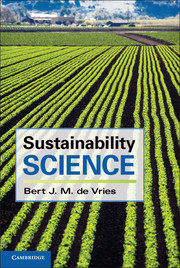Book contents
- Frontmatter
- Contents
- Preface
- 1 Introduction
- 2 The System Dynamics Perspective
- 3 In Search of Sustainability: Past Civilisations
- 4 The World in the Past 300 Years: The Great Acceleration
- 5 Sustainability: Concerns, Definitions, Indicators
- 6 Quality of Life: On Values, Knowledge and Worldviews
- 7 Energy Fundamentals
- 8 On Knowledge and Models
- 9 Land and Nature
- 10 Human Populations and Human Behaviour
- 11 Agro-Food Systems
- 12 Renewable Resources: Water, Fish and Forest
- 13 Non-Renewable Resources: The Industrial Economy
- 14 Towards a Sustainable Economy?
- 15 Outlook on Futures
- Glossary
- References
- Index
- Plate Section
- References
2 - The System Dynamics Perspective
Published online by Cambridge University Press: 05 January 2013
- Frontmatter
- Contents
- Preface
- 1 Introduction
- 2 The System Dynamics Perspective
- 3 In Search of Sustainability: Past Civilisations
- 4 The World in the Past 300 Years: The Great Acceleration
- 5 Sustainability: Concerns, Definitions, Indicators
- 6 Quality of Life: On Values, Knowledge and Worldviews
- 7 Energy Fundamentals
- 8 On Knowledge and Models
- 9 Land and Nature
- 10 Human Populations and Human Behaviour
- 11 Agro-Food Systems
- 12 Renewable Resources: Water, Fish and Forest
- 13 Non-Renewable Resources: The Industrial Economy
- 14 Towards a Sustainable Economy?
- 15 Outlook on Futures
- Glossary
- References
- Index
- Plate Section
- References
Summary
Introduction
To develop a proper framework for sustainability science, we must learn to think and model across disciplines and in terms of complex systems. In the last couple of centuries, many mathematical methods and techniques have been developed, which have become the hallmark of the natural sciences and their successes. Since the 1960s, the evolution of these methods and their applications became closely linked because of the advent of the computer and its rapid advances in performance. Mathematical modelling has become standard practise in the natural and engineering sciences, and increasingly in the life and social sciences. Scientists in many disciplines now have access to simulation software and models.
The roots of system theory go back to the early days of the Enlightenment, in natural science as well as in social science (Richardson 1991). Its present-day form emerged in the 1930s, inspired by insights in biology and ecology. In the second half of the 20th century, system analysis got its specific content from control engineering (cybernetics) and electro-mechanical engineering, which emphasises ‘the larger picture’ by shifting the focus from events to behaviour to structure. System analysis has been applied in a variety of engineering, management, economic, social and resource contexts.
- Type
- Chapter
- Information
- Sustainability Science , pp. 14 - 53Publisher: Cambridge University PressPrint publication year: 2012



